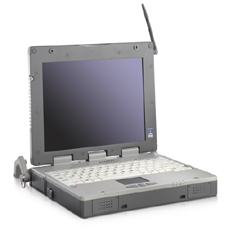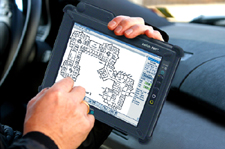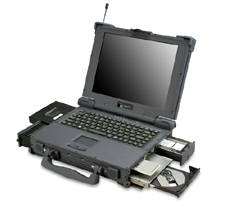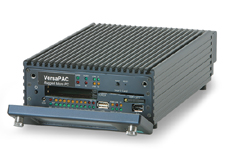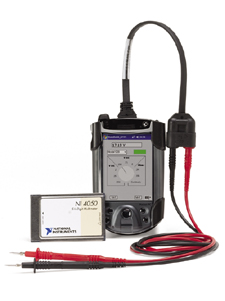Bulletproof Performers
When the going gets tough, the tough log on to their rugged portables.
Latest News
August 1, 2004
By Glenn Hartwig
The nice thing about rugged portables is that they come in enough sizes and stylesto fit into just about every niche the environment offers. If you don’t see whatyou want in a clamshell-type laptop, then maybe a briefcase or lunchbox stylewill do. If neither of those fill the bill, you can check out tablets. No, stillnot what you’re after? How about a rugged PDA?
Got Horsepower?Take, for instance, the portable approach exemplified by MaxVision of Madison,Alabama. The company’s briefcase-style portables, according to company PresidentBruce Imsand, “have all of the current technology features that you would expectto see on the latest uniprocessor tabletop ]computer], plus a full, 17-inch, 12803 1024 bright display, full-size keyboard, and a mouse, all packed up into thissix-inch briefcase that, with two hard drives, weighs about 29 pounds.”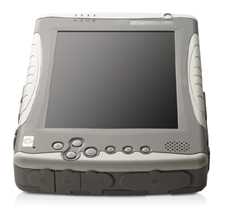
Above, left: The HP nr3600 is designed for wireless computing in the field orin service users in extreme conditions. It has a 1.7 GHz Intel Pentium 4-M processor.Above, right: The company’s tr3000 offers rugged features and wireless computingcapabilities to mobile users in extreme conditions. It uses the Intel PentiumIII 933MHz ultra-low voltage processor.
Granted, this is not something that’s going to fly away in a stiff breeze but,“this is a different class of beast; a rugged, moderate-weight, no-compromisemachine that’s available to do any serious design-related work,” says Imsand.“It is the video market that has the most voracious appetite for products of thissort. It turns out that maybe 50 percent of our ‘M’ class machines delivered inthe world today are used for web-streaming applications where people will go toa remote location and provide video for broadcast over the Internet.”
There are yet bigger horses in the MaxVision stable—its “X” class is “a dual-processorXeon machine that can be configured up to eight gigabytes of RAM, up to two terabytesof disk storage, has five PCIX slots, and supports up to three 19-inch displays,“says Imsand. “The guys that are using this machine are into not only data acquisition,but simulation, satellite imagery, and high-definition video applications.”
Top, left: The Dolch PDI is a rugged handheld with an 8.4-in. screen for full-documentview on a handheld unit. Top, right: Dolch’s VersaPAC is a tough micro PC. Bottom,right: The Dolch NotePAC is sealed from water, salt air, dust, and dirt. The cast-magnesiumcase includes shock-mounted components.
What’s next in this category? Imsand says he believes that communications featureslike voice-over Internet protocol (VoIP) are going to be big players in the nearfuture. “Wherever I am, my phone calls follow me through the Internet. So yousee, if you’ve got that much storage in a portable product like this, and allyour information is in there, and all your communications are there, then youreally have a totally different definition of an office. And I believe that tobe revolutionary.”
Scaling UpThe approach HP takes is a somewhat different tack from that espoused by MaxVision.HP’s position is one of broadening the rugged portable’s penetration into thegeneral laptop and PDA markets by capitalizing on the virtues of increased survivability.
According to Ben Thacker, rugged product marketing manager at HP, “The past…hasbeen about having a product that can withstand a harsh environment and so thingslike speeds and feeds, processors, and different types of drives, or the latestand greatest technology wasn’t really that important to customers. With HP comingin, I think that one thing we can do is drive the supply. I can choose the processorsand other components that I want because I know I can get the supplies, beingone of the top-tier PC distributors in the world.”
When it comes to technological developments, however, Thacker says screen improvementsare where HP is making strides. “What we hope to drive to in panel technologyis a transflective/transmissive display,” he says. It combines a backlit screenfor the dark with transflective capability for sunlight.
Thacker notes that combining wireless communications with rugged portables isanother interesting development. “The products I have include three integratedradios,” he says, “which means my users can have integrated wireless LANs…WANs,and…Bluetooth, all at one time.”
HP is also pursuing extended battery times. Thacker says the company is evaluatingvarious “new battery technologies that we can use to enhance the life of our productsin the field.” He mentions the possibility of exploring solar technologies: “We’relooking at it,” he says. “I don’t know if it’s going to work, but we’re lookingat that, along with…new technologies ]to] keep products working longer.”
Tight FocusChris McDonald, former director of marketing for Dolch Computer Systems, Inc.,of Fremont, California, noted some of the same trends as HP’s Thacker when hediscusses the rugged portable market and, like both Thacker and Imsand of MaxVision,he sees communications playing a prominent role in the expansion of the class.
“There are people who are used to using ]wireless and handheld technologies]in normal situations,” he says, “but are finding that need in more rugged applications,as well.” Examples include personnel from emergency response agencies lookingfor smaller, lighter handheld products that can be combined with a wireless connection.In response, says McDonald, Dolch has “developed a rugged handheld called theDolch PDI. It’s basically a PDA but we’ve increased the screen size to 8.4 inchesas opposed the 3.5 inches that you normally see on a standard PDA.”
McDonald says the main advantage is the ability to have full-document view ona handheld unit. “People can use the compact flash to save information onto thePDI itself,” says McDonald, “or use a wireless connection to a PC. So, if there’sa computer in their vehicle, they can communicate wirelessly with that…downloadthe information that they’re going to need and, when they’re out of range, they’restill able to view and access the documents offline.”
According to McDonald, many users who started with rugged portables tried notebooksand tablets. Now Dolch is hoping to provide the happy medium whereby a ruggedportable system with PCI slots is crossed with a wireless display for more mobility.The ideal unit should have all the power of a rugged portable and the flexibilityof something you can hold in the palm of your hand.
Rugged Is GoodYou can’t keep a good idea down. Heck, sometimes you can’t even get a leash onit.
It’s nice to see rugged qualities spilling over into the development of everydayportables and laptops. Maybe they should have been rugged from the beginning.If sturdiness and reliability catch on, they might translate into a new crazein everything from cars to cuisine. And if not, at least it’s good to be a fashionleader in computers.
Glenn Hartwig is a technical writer who lives in southwestern New Hampshire. You can send feedbackvia e-mail c/o Desktop Engineering Feedback.
When Really Small is Really BeautifulHandheld PDAs are getting tougher every day and they’re increasingly findingtheir way into situations where they have to do things like record data in exposedenvironments. Kristi Fairchild, DAQ product manager for National Instruments,says she’s seen a trend in using handhelds to collect measurements.
The company’s LabVIEW PDA allows users to develop measurement applications ona desktop before downloading it to a PDA. “We’ve had a lot of vendors talkingto us,” says Fairchild. “We’ve talked to a lot of companies that make these ruggedhandheld devices and they’ve got some really interesting ideas as far as usingrugged PDAs for measurements.”
“We can also integrate our data acquisition hardware,” she notes. “There’s aPDA called a Compaq Ipac that has a PCMCIA slot in a little sleeve that you attachto the PDA. That type of PDA also has integrated Bluetooth and 802.11 communicationscapabilities and we’ve got a customer in Maryland using LabView PDA and the DAQcard on medivac helicopters to assess brain injuries.”
When even a laptop is too big and bulky, and a patient’s life is on the line,there are solutions when you know where to look. —GH
Subscribe to our FREE magazine, FREE email newsletters or both!
Latest News
About the Author
DE’s editors contribute news and new product announcements to Digital Engineering.
Press releases may be sent to them via [email protected].







